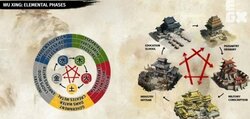Difference between revisions of "Wuxing"
(Added more info) |
(Added navbox and missing category) |
||
| Line 48: | Line 48: | ||
=== Works with an indefinite number of types === | === Works with an indefinite number of types === | ||
* ''[[Pokémon]]'': A total of 18 types. | * ''[[Pokémon]]'': A total of 18 types. | ||
| + | |||
| + | {{Fantasy}} | ||
| + | |||
| + | [[Category:Artistic archetypes]] | ||
[[zh:五行]] | [[zh:五行]] | ||
Latest revision as of 15:51, 30 September 2024
Moegirlpedia would welcome your assistance in improving this article☆Kira~
As you read this article, you're welcome to participate in editing this page. Before editing, please read the wiki quickstart, editing guidelines and retrieve relevant information. We wish you a good time on Moegirlpedia. |
 | |
| Base Info | |
| Term | Wuxing |
|---|---|
| Origin | Chinese culture |
| Related Articles | bagua |
Wuxing (五行) is a classical concept of Chinese philosophy.
Contents
Introduction
Traditionally, it is believed that the five classical elements are classical Chinese philosophical thought, based on the abstract analogy that all things in the world have an inherent connection. A set of theoretical models formed by a cognitive view of change, evolution, the simple abstraction of all things into the five elements of Gold, Wood, Water, Fire, and Earth.
The relationship between the five elements is "mutually supportive (mutually exclusive)": Wood births fire, fire births earth, earth births gold, gold births water, water births wood; wood overcomes earth, earth overcomes water, water overcomes fire, fire overcomes gold, gold overcomes wood.
The earliest concept related to Wuxing may be the five directions: Wood in the East, Fire in the South, Earth in theCenter, Gold in the West, and Water in the North; through the concept of the five directions, the five elements are linked to the heavenly stems, and in turn are related to concepts such as the earthly stems, and the four seasons.
After the Yin-Yang School among the Hundred Schools of Thought, the concept of wuxing and the Yin and Yang from the "Book of Changes", and the matching and pairing of bagua in the Warring States period, the concepts of "yin and yang", "five elements" and "eight trigrams" were developed simultaneously.
Works with this concept
- Armor Hero: The Armors: Dragon Man (Fire), Eagle Man (Wood), Rhino Man (Gold), Mastiff Man (Water), Tiger Man (Earth). The five main characters are descendants of the villages named after the elements.
- Total War: Three Kingdoms: The wuxing system involves all aspects of the game, and it is related to in-game trade, agricultural production, military affairs, diplomacy and politics among others.
- Touhou Project:
- Patchouli Knowledge's spell card is based around the theme of Seven Elements, however, the actual presentation uses the effect of symbolizing Fire, Water, Wood, Metal and Earth.
- Master Raindrop
- Master Raindrop: Water
- Niwa: Earth
- Shao Yen: Wood
- Jinhou: Metal (Gold)
- Flamo: Fire
- GG Bond series:
- Monster Hero-Dream Guardians
- GG Bond: Metal (Gold)
- Phoebe: Fire
- S-Daddy: Ice (Water)
- Super Q: Stone (Earth)
- Bobby: Wood
- Monster Hero-Dream Guardians
Derivatives
The most prominent feature of wuxing is that the elements interact with each other. In ACG works, because Earth and Wood's attacking power is hard to express, they are often replaced with wind and thunder. There are other works that substitute the "Gold, Wood, Water, Fire, Earth" attributes for completely different ones, there are also representations of restraints in ACG works, that is, three of these attributes restrain each other, and the remaining two attributes are restrained in pairs.
Works with "five" types
- Beastie Bay: Earth overcomes thunder, thunder overcomes water, water overcomes fire, fire overcomes wind, wind overcomes earth.
- Sword and Fairy: Earth overcomes water, water overcomes fire, fire overcomes thunder, thunder overcomes wind, wind overcomes earth.
Works with an indefinite number of types
- Pokémon: A total of 18 types.
| |||||||||||||||||||||||||||||||||||||||||||||||||||||||||||||||||